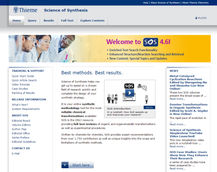Pharmaceutical Substances
Look up Industrial Syntheses of 2,600 APIs

Pharmaceutical Substances is a one-stop source of information relating to the industrial synthesis and commercial applications of every licensed drug of significance. It provides ready access to syntheses, patents, and applications for more than 2,600 active pharmaceutical ingredients (APIs).
For more than 30 years, Pharmaceutical Substances has been a standard reference in the chemical and pharmaceutical industry.
Each Active Pharmaceutical Ingredient Record Includes:
- Chemical structure
- Graphical representation of synthetic route including intermediates
- Nomenclature: INN standard, trivial names, synonyms, CAS number ATC codes
- Medical applications/Therapeutic category
- Toxicological data
- Patent number, origin, holder and date of application Commercial information: Vendor and trade names for 6 major world markets
- Bibliographic information including CASSI codes
Essential for Research in the Pharmaceutical Industry
- Full synthetic route for the industrial manufacture of each drug elucidated from the patent literature
- Unique source of reactions that perform on an industrial scale
- Overview of the pharmaceutical industry from a synthetic chemist’s perspective
- Insights into a therapeutic area and chemically related substances
Essential for Business Development in the API Industry
- First determination of the market size and competition for an API – essential for development of new and generic pharmaceuticals
- Source of markets for synthesis intermediates, ingredients and enzymes
- Patent information including approval date and expiration
- Comprehensive coverage of older APIs and substances approved worldwide
- Merger and acquisition tracking ensuring that vendor information is up-to-date in a rapidly changing industry
Essential for Teaching in Medicinal and Pharmaceutical Chemistry
- Capability to search for marketed drugs relating to a structure or reaction
- A rapid overview of a therapeutic area or chemically related substances
- Industrial synthetic routes discerned from complex patent descriptions
- Insights into industrial processes and toxicity issues
- Commercial information such as trade names and vendors/manufacturers for six world markets
- Concise records ideal for hand-outs and quick reference
What Others Say about Pharmaceutical Substances
"As a process research and development chemist, I appreciate the detailed reaction schemes which inform me how every drug on the market can be made and the detailed references to not only the published literature but to patents."
Dr. Trevor Laird, formerly Scientific Update LLP and Editor of Organic Process Research and Development
"Anticancers are still the main focus of drug development. This is reflected also in the approval practice of FDA and EMA within the last 5 years with a relatively high share of new anticancer drugs. As a consequence, the new update with in total 17 monographs contains 7 recently approved anticancers, and 5 of them are protein kinase inhibitors."
Prof. Dr. Axel Kleemann, Pharmaceutical Substances author (Johann Wolfgang Goethe University, Frankfurt am Main), about Update 4.1
Request information about Pharmaceutical Substances now

Technical literature: Pharmaceutical Substances
Look up Industrial Syntheses of 2,600 APIs
Product classification Pharmaceutical Substances
Product categories
Applications
Manufacturers of similar products
Find more technical literature and related products
Find Pharmaceutical Substances and related products in the theme worlds
Topic world Synthesis
Chemical synthesis is at the heart of modern chemistry and enables the targeted production of molecules with specific properties. By combining starting materials in defined reaction conditions, chemists can create a wide range of compounds, from simple molecules to complex active ingredients.

Topic world Synthesis
Chemical synthesis is at the heart of modern chemistry and enables the targeted production of molecules with specific properties. By combining starting materials in defined reaction conditions, chemists can create a wide range of compounds, from simple molecules to complex active ingredients.


